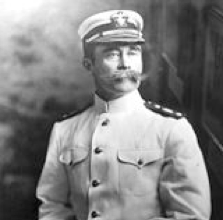Robert Peary




Early years
Robert Edwin Peary was born in Cresson, Pennsylvania in 1856. Peary graduated from Bowdoin College, Phi Beta Kappa,[1] in 1877.[2] His home in Fryeburg, Maine still remains in pristine condition as an inn known as the Admiral Peary House.
Peary was a brother of the Delta Kappa Epsilon fraternity (Theta chapter).
]Initial Arctic expeditions
Peary made several expeditions to the Arctic, exploring Greenland by dog sled in 1886 and 1891 and returning to the island three times in the 1890s. He twice attempted to cross northwest Greenland over the ice cap, discovering Navy Cliff. American artist F. W. Stokes joined some of these expeditions.
Unlike most previous explorers, Peary studied Inuit survival techniques, built igloos, and dressed in practical furs in the native fashion both for heat preservation and to dispense with the extra weight of tents and sleeping bags when on the march. Peary also relied on the Inuit as hunters and dog-drivers on his expeditions, and pioneered the use of the system (which he called the "Peary system") of using support teams and supply caches for Arctic travel. His wife, Josephine, accompanied him on several of his expeditions. During the course of his explorations, he had 8 toes amputated.
Peary's fame
His 1898-1902 expedition was darkened by an unfounded attempt to put forth an 1899 visual discovery of "Jesup Land" west of Ellesmere, leading to his allegation that this was his sighting of Axel Heiberg land prior to its discovery by Norwegian explorer Otto Sverdrup's expedition, a Peary claim now universally rejected. However, the genuine achievements of this remarkable expedition were weightier. The gold medals of the American Geographical Society and Royal Geographical Society of London honored Peary's tenacity, his mapping of his considerable real discoveries, and his discovery in 1900 of Cape Jesup at the north tip of Greenland. Peary also achieved a farthest north for the western hemisphere in 1902 north of Canada's Ellesmere Island.
The 1905-06 expedition
Peary's next expedition was supported by a $50,000 gift by George Crocker. Peary then used the money for a new ship. Peary's new ship Roosevelt battled its way through the ice between Greenland and Ellesmere Island to an American hemisphere farthest north by ship. The 1906 "Peary System" dogsled drive for the pole across the rough sea ice of the Arctic Ocean started from the north tip of Ellesmere at 83° north latitude. The parties made well under 10 miles (16 km) a day until they became separated by a storm, so Peary was inadvertently without a companion sufficiently trained in navigation to verify his account from that point northward. With insufficient food and with the negotiability of the ice between himself and land an uncertain factor, he made the best dash he could and barely escaped with his life off the melting ice. On April 20, he was no further north than 86°30' latitude[3] yet he claimed to have the next day achieved a Farthest North world record at 87°06' and returned to 86°30' without camping, an implied trip of at least 72 nautical miles (83 statute miles) between sleeping, even assuming undetoured travel.
After returning to the Roosevelt in May, Peary in June began weeks of further agonizing travel by heading west along the shore of Ellesmere, discovering Cape Colgate, from the summit of which he claimed in his 1907 publications[4] he had seen a previously undiscovered far-north "Crocker Land" to the northwest on June 24 of 1906. Yet his diary for this time and place says "No land visible"[5] and Crocker Land was in 1914 found to be non-existent by Donald MacMillan and Fitzhugh Green. On December 15, 1906 the National Geographic Society, which was primarily known for publishing a popular magazine, certified Peary's 1905-6 expedition and Farthest with its highest honor, the Hubbard Gold Medal; no major professional





profile


Cresson, Pennsylvania Died February 20, 1920 (aged 63) Nationality American Known for Geographic North Pole



favorites




About Robert Peary



